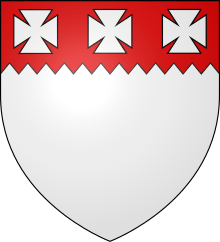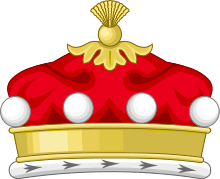Earl of Egmont
Earl of Egmont was a title in the Peerage of Ireland, created in 1733 for John Perceval, 1st Viscount Perceval. It became extinct with the death of the twelfth earl in 2011.
| Earldom of Egmont | |
|---|---|
  Argent, on a chief indented gules three crosses patée of the field[1] | |
| Creation date | 6 November 1733 |
| Monarch | George II |
| Peerage | Peerage of Ireland |
| First holder | John Perceval |
| Last holder | Thomas Gerald, 12th Earl of Egmont |
| Remainder to | Heirs male of the 1st Earl's body lawfully begotten |
| Subsidiary titles | Viscount Perceval Baron Perceval Baron Lovel and Holland (GB) Baron Arden (I) |
| Status | Extinct |
| Extinction date | 6 November 2011 |
| Motto | Sub cruce candida ("Under the white cross")[1] |
History
The Percevals claimed to be an ancient Anglo-Norman family, a branch of the House of Yvery.[2][3] This branch of the family traces its lineage to David Perceval, Lord of Tykenham, Rolleston, Sydenham, Moreland, Weley, and Wolmerton in Somerset, in the 16th century. His grandson was Sir Richard Percivale (1550–1620), agent of William Cecil, 1st Baron Burghley. Sir Richard deciphered coded letters that gave Queen Elizabeth I the first intelligence of the Spanish Armada. He served as Secretary of the Court of Wards and Registrar of the Court of Wards in Ireland, where he acquired large estates.[1]
Sir Richard's son Sir Philip Perceval (1605–1647), obtained grants of forfeited lands in Ireland to the amount of 101,000 statute acres. His eldest son, John Perceval, on 9 September 1661, was created a Baronet, of Kanturk in the County of Cork, in the Baronetage of Ireland. The baronetcy was created by patent with a clause, that the eldest son, or grandson, would become a baronet after the age of 21, and during the lifetime of the father or grandfather, as the case would be.[4][1]
Robert (1657–1677), second son of the first baronet, was assassinated in 1677 by an unknown hand, in the Strand, London. The first baronet was succeeded by his eldest son, the second Baronet, who died unmarried at an early age and was succeeded by his younger brother, the third Baronet. He also died at an early age and was succeeded by his eldest son, the fourth Baronet. He died at the age of nine and the titles were inherited by his younger brother, the fifth Baronet, John Perceval. He represented Cork in the Irish House of Commons and Harwich in the British House of Commons and also served as the first President of the trustees of Georgia. Perceval was created Baron Perceval, of Burton in the County of Cork, in 1715, with remainder to the heirs male of his father, and Viscount Perceval, of Kanturk in the County of Cork, in 1722, and Earl of Egmont in 1733, with remainder to the heirs male of his body.[4] All three titles were in the Peerage of Ireland. Perceval claimed descent from the Egmonts of Holland but the title of the earldom was taken from a place in County Cork where the family owned an estate.
His son, the second Earl, was a prominent politician and notably served as First Lord of the Admiralty. In 1762 he was created Baron Lovel and Holland, of Enmore in the County of Somerset, in the Peerage of Great Britain, which gave him an automatic seat in the British House of Lords. His seventh son (second from his second marriage) was Prime Minister the Rt. Hon. Spencer Perceval (who was assassinated by John Bellingham in the lobby of the House of Commons, in 1812).
Lord Egmont was succeeded by his eldest son, the third Earl, who sat as a Member of Parliament for Bridgwater. His grandson, the fifth Earl, briefly represented East Looe in the House of Commons. He was succeeded by his cousin, the sixth Earl, who had already succeeded his father as third Baron Arden (see below). He was Member of Parliament for West Surrey. On his death the titles passed to his nephew, the seventh Earl. He was the son of Reverend the Hon. Charles George Perceval, fourth son of the second Baron Arden. He represented Midhurst in Parliament as a Conservative. He was succeeded by his first cousin once removed, the eighth Earl. He was the grandson of Reverend the Hon. Arthur Philip Perceval, sixth son of the second Baron Arden. On the death in 1929 of his younger brother, the ninth Earl, this line of the family also failed and the titles became dormant.[1]
They were claimed by the late Earl's third cousin Frederick Joseph Trevelyan Perceval, who lived in Canada. He was the grandson of Frederick James Perceval, second son of Prime Minister Spencer Perceval, seventh son of the second Earl. He died in 1932 before he had established his claim. However, in 1939 the House of Lords allowed the claim of his only son Frederick George Moore Perceval, who became the eleventh Earl (his father having posthumously been deemed the tenth Earl). At his death in 2001, the eleventh Earl was succeeded in the earldom by his eldest and sole surviving son Thomas Frederick Gerald Perceval.[5]
The twelfth Earl never married, and upon his death on 6 November 2011 the earldom and all of its subsidiary titles became extinct.[6]
The title of Baroness Arden, of Lohort Castle in the County of Cork, was created in the Peerage of Ireland in 1770 for Catherine Perceval, Countess of Egmont, second wife of the second Earl of Egmont. She was the daughter of the Hon. Charles Compton, younger son of George Compton, 4th Earl of Northampton. Lady Arden was succeeded by her eldest son, the second Baron. He represented Launceston, Warwick and Totnes in Parliament and served as Master of the Mint from 1801 to 1802. The latter year he was created Baron Arden, of Arden in the County of Warwick, in the Peerage of the United Kingdom. He was succeeded by his eldest son, the third Baron, who in 1841 succeeded his cousin as sixth Earl of Egmont.[1]
Mount Taranaki/Egmont in New Zealand was named after the second Earl of Egmont by James Cook.
Perceval Baronets, of Kanturk (1661)
- Sir John Perceval, 1st Baronet (1629–1665) — created 9 September 1661.
- Sir Philip Perceval, 2nd Baronet (1656–1680)
- Sir John Perceval, 3rd Baronet (1660–1686)
- Sir Edward Perceval, 4th Baronet (1682–1691)
- Sir John Perceval, 5th Baronet (1683–1748) (created Earl of Egmont in 1733)
Earls of Egmont (1733)
- John Perceval, 1st Earl of Egmont (1683–1748)
- John Perceval, 2nd Earl of Egmont (1711–1770)
- John James Perceval, 3rd Earl of Egmont (1738–1822)
- John Perceval, 4th Earl of Egmont (1767–1835)
- Henry Frederick Joseph James Perceval, 5th Earl of Egmont (1796–1841)
- George James Perceval, 6th Earl of Egmont (1794–1874)
- Charles George Perceval, 7th Earl of Egmont (1845–1897)
- Augustus Arthur Perceval, 8th Earl of Egmont (1856–1910)
- Charles John Perceval, 9th Earl of Egmont (1858–1929) (dormant)
- Frederick Joseph Trevelyan Perceval, de jure 10th Earl of Egmont (1873–1932)
- Frederick George Moore Perceval, 11th Earl of Egmont (1914–2001) (claim admitted 1939)
- Thomas Frederick Gerald Perceval, 12th Earl of Egmont (1934–2011)
Barons Arden (1770)
- Catherine Perceval, Countess of Egmont, 1st Baroness Arden (died 1784) (in the Peerage of Ireland)
- Charles George Perceval, 2nd Baron Arden (1756–1840) (created Baron Arden in the Peerage of the United Kingdom in 1802)
- George James Perceval, 6th Earl of Egmont, 3rd Baron Arden (1794–1874) (succeeded as Earl of Egmont in 1841)
see above for further holders
Line of succession





- Cecil Perceval (1739–1753)
- Philip Perceval (1741–1785)
- Edward Perceval (1744–1829)
- Frederick Perceval (1749–1757)

- Charles Perceval (1793–1793)
- John Perceval (1793–1818)

- Edward Perceval (1795–1840)
- Charles Perceval (1796–1858)

- Arthur Perceval (1799–1853)
- Augustus Perceval (1829–1896)
- Charles Perceval (1831–1894)


- Spencer Perceval (1832–1910)
- Arthur Perceval (1858–1893)
- Henry Perceval (1861–1884)
- Spencer Perceval (1762–1812)
- Spencer Perceval (1795–1859)
- Spencer Perceval (1828–1890)
- John Perceval (1833–1863)
- Norman Perceval (1838–1902)
- Frederick James Perceval (1797–1861)
- Spencer Frederick Perceval (1829–1887)
- George Perceval (1847–1920)



- Patrick Perceval (1936–1937)
- Gordon Perceval (1945–1949)
- George Perceval (1874–1965)
- Charles Perceval (1848–1898)
- Gordon Perceval 1891–)
- Montagu Perceval (1850–1923)
- James Perceval (1854–1905)
- Spencer Ralph Perceval (1889–)
- Dudley Perceval (1800–1856)
- Charles Perceval (1829–1889)
- Dudley Perceval (1874–1956)
- Philip Perceval (1915–1996)
- Dudley Perceval (1874–1956)
- Edward Perceval (1877–1900)
- Charles Perceval (1829–1889)
- John Thomas Perceval (1803–1876)
- Ernest Augustus (1807–1896)
- Ernest Perceval (1835, d. 14 Mar 1924)
- Spencer George Perceval (1838, d. 7 Mar 1922)
- Alfred Perceval (1843, d. 11 Mar 1935)
- Cecil Henry Spencer Perceval (1849, d. 8 May 1920)
- Spencer Perceval (1795–1859)
- Spencer Perceval (1762–1812)
Family seats
The family seats were as in the names of the territorial designations. Other major homes funded or expanded by the family included:
- Great Burgh, Epsom Downs/Tattenham Corner, Surrey, England[7]
See also
Notes
- Mosley, Charles, ed. (2003). Burke's Peerage, Baronetage & Knighthood (107 ed.). Burke's Peerage & Gentry. pp. 1286–1288. ISBN 0-9711966-2-1.
- Collins, Arthur (1779). The Peerage of England: Containing a Genealogical and Historical Account of All the Peers of that Kingdom. W. Strahan, J. F and C. Rivington. Retrieved 11 October 2017.
- Anderson, James (1742). A genealogical history of the house of Yvery, in its different branches of Yvery, Luvel, Perceval and Gournay. H. Woodfall, jun. p. 27. Retrieved 11 October 2017.
- Gibson, Charles Bernard (1861). The history of the county and city of Cork, Volume 2, T.C. Newby. p. 68 footnote])
- "The Earl of Egmont". The Daily Telegraph. 3 January 2002. Retrieved 11 October 2017.
- Fredrick and Constance Perceval Obituary, Calgary Herald
- H.E. Malden (editor) (1911). "Parishes: Banstead". A History of the County of Surrey: Volume 3. Institute of Historical Research. Retrieved 9 January 2014.CS1 maint: extra text: authors list (link)
References
- Chisholm, Hugh, ed. (1911). . Encyclopædia Britannica. 9 (11th ed.). Cambridge University Press. p. 18.
External links
- Article on the eleventh Earl
- Hansard 1803–2005: contributions in Parliament by John Perceval, 4th Earl of Egmont
- Hansard 1803–2005: contributions in Parliament by Henry Frederick Joseph James Perceval, 5th Earl of Egmont
- Hansard 1803–2005: contributions in Parliament by Charles George Perceval, 7th Earl of Egmont
- Hansard 1803–2005: contributions in Parliament by Augustus Arthur Perceval, 8th Earl of Egmont
- Hansard 1803–2005: contributions in Parliament by Charles John Perceval, 9th Earl of Egmont
- Hansard 1803–2005: contributions in Parliament by Frederick Joseph Trevelyan Perceval, de jure 10th Earl of Egmont
- Hansard 1803–2005: contributions in Parliament by Frederick George Moore Perceval, 11th Earl of Egmont